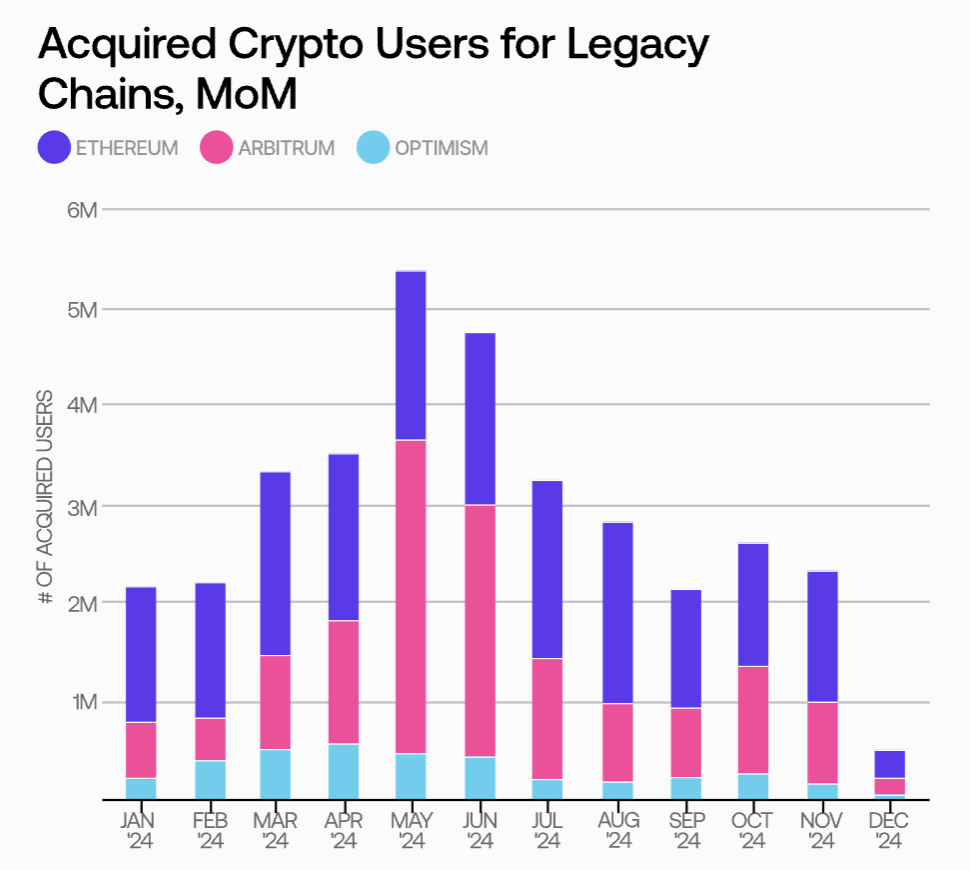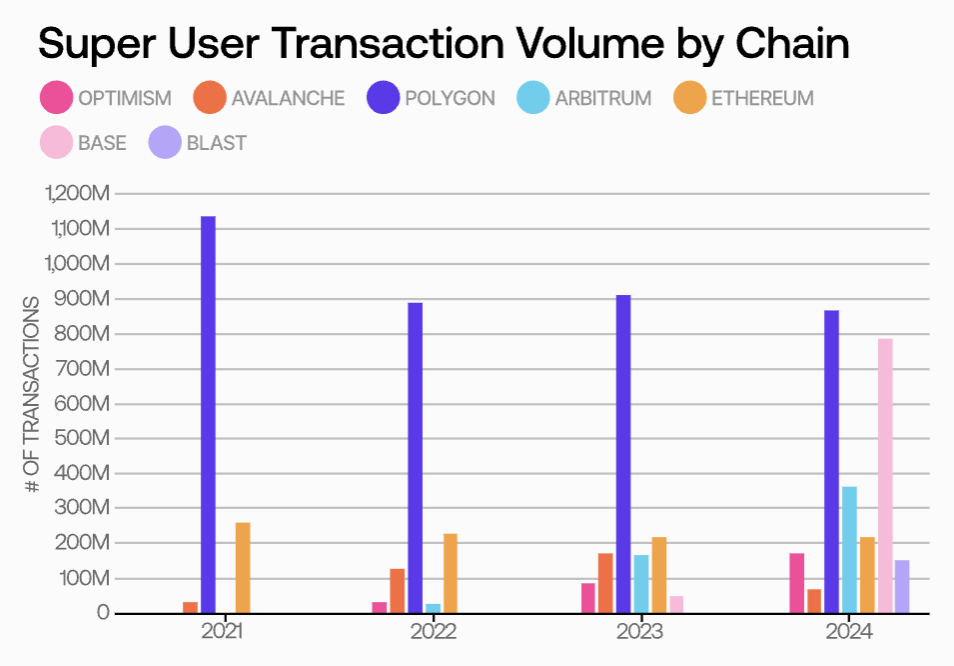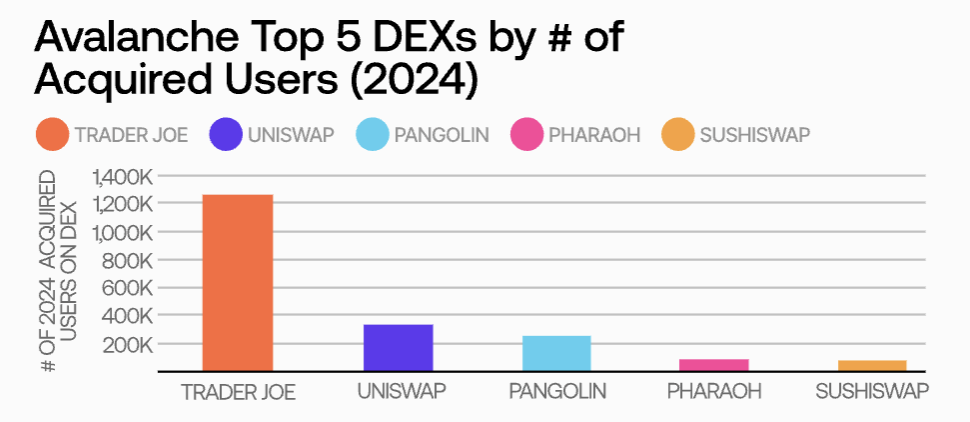1. Introduction
On-chain user trends towards 2025
2024 was a pivotal year for Web3 user growth, with record-high new users and super users across major mainnet. Chains like Base have redefined what exponential growth looks like, while Ethereum and its L2 solutions have demonstrated how entrenched ecosystems can adapt to evolving user demands.
However, deeper data analysis reveals that not all growth is created equal - highlighting the importance of focusing on quality, not just quantity, when assessing on-chain activity.
To this end, this report leverages Flipside's real-time 2024 on-chain crypto user data to evaluate this year's crypto activity through more actionable multi-variate metrics, beyond just traditional performance indicators, to provide new ways to assess the health of on-chain users in 2025.
Executive Summary
Beneath the headlines of user growth lies a deeper challenge: how to build ecosystems that foster meaningful, sustained engagement, not just fleeting speculation.
In short, most blockchains remain in the early stages of converting casual users into high-value contributors.
User Acquisition:
Base: Set a record of 19.4M new users in October 2024, with Base contributing 13.7M - nearly 8x the second-place Polygon.
BTC: Despite BTC price hitting new highs above $100K, Bitcoin's monthly user acquisition averaged just 935,900, indicating speculation among existing users rather than significant new entrants.
ETH: Averaged 1.56M monthly new users, outpacing Arbitrum and Optimism, with a 33.4% QoQ user growth spike in March.
Super Users:
Base: Attracted 15.1M wallets with 100+ DeFi txs, 38.4% more than Ethereum's 10.7M super users.
ETH: 10.9M DeFi-related super users exceeded the combined total of Arbitrum (6.2M) and Optimism (1.8M), highlighting Ethereum's liquidity and accessibility advantages.
Polygon: Added 1.5M new super users in 2024 and recorded 867.7M super user txs, underscoring its success beyond DeFi.
DEX Usage:
Uniswap: Expanded its dominance across major chains, capturing 91.3% of new user DEX activity on Base and growing its market share on Ethereum by 27.72% vs. 2023.
While Uniswap grew, Trader Joe maintained its lead on Avalanche with a 61.1% market share, up 6.1% from 2023.
Unlike 2023, the top 3 DEXes by new users and super users are now consistent across all observed chains in 2024.
2. New User Acquisition
New user acquisition peaked at 19.4M monthly in October 2024.
This year's on-chain user growth was led by Base, contributing 13.7M new users that month - nearly 8x the second-place Polygon. Overall, it has been an impressive year for the broader on-chain user acquisition industry, with user growth trending upwards throughout 2024 aside from a minor dip in August.
Note: "New users" are defined as users who have made at least 2 txs on a chain, with the second tx occurring in 2024.

This sustained growth may be influenced by increased institutional crypto adoption, as evidenced by the BTC and ETH ETF announcements earlier this year.
Other exciting developments in H1 2024, such as Grayscale listing multiple new crypto assets as "under consideration" and the FOMC's 50bps rate cut in September 2024 - the first in 4 years - may have also contributed to this optimistic sentiment.
Base's Remarkable Growth
Base started 2024 slowly but has since seen a 56x explosion in monthly new users since January.
Base had just 244,700 new users in January, but experienced steady and significant growth throughout the year. By November, the chain's monthly new users had grown 56x compared to January, averaging 4.7M new users per month in 2024.
The chain's performance has greatly benefited from Coinbase's massive user base, collectively controlling around $130B in assets. Popular DeFi protocols like Aerodrome may have also attracted users from other EVM chains, while Base has successfully driven user interest through meme coin trading and on-chain AI initiatives like Based Agents.
Bitcoin's Performance
Despite BTC price hitting new highs, it has not attracted a significant influx of new users this year.
Bitcoin's new user acquisition remained relatively flat in 2024, despite the substantial BTC price appreciation. Overall, Bitcoin averaged 935,900 new users per month this year, ranking third-to-last among the seven legacy chains observed.
This suggests that the BTC price increase has been driven more by enthusiasm and speculation from its existing user base, rather than substantial new user onboarding.
In March 2024, BTC's first major price surge coincided with a 19.2% QoQ increase in new users, but in November - when BTC reached the long-awaited $100K milestone amid continued price appreciation - new user acquisition actually declined 28.5% QoQ.
Ethereum and L2s Performance
Ethereum's new user acquisition has outpaced its legacy L2s overall, but Arbitrum has also seen an impressive single-month spike.
Ethereum's growth has exceeded its two leading L2 chains in 2024, averaging 1.56M new users per month, compared to 1.2M for Arbitrum and 348,800 for Optimism. Excluding December, Ethereum only saw 4 months of QoQ declines, and reached a monthly peak of 1.9M new users in March - a 33.4% QoQ increase.
Arbitrum and Optimism both started the year with strong momentum, reaching their respective 2024 new user growth peaks in April and May, before tapering off for the rest of the year.

However, it's worth noting that Arbitrum's 3.3M new users in May exceeded Ethereum's highest single-month peak in 2024. In this context, Arbitrum's new user growth has outpaced Optimism all year, benefiting from the success of Arbitrum One and its integration into GameFi and SocialFi. With 169 builder grants approved in H1 2024 and many behind-the-scenes developments, whether Arbitrum can reclaim its position as the leading global EVM L2 remains to be seen.
2024 New Chain Performance
Among the new chains launched in 2024, Aleo achieved the highest average new user growth, while Blast saw a record single-month spike before tapering off.
For new chain launches, Aleo saw the highest new user growth in its launch month, averaging 175,200 new users, compared to 134,900 for Blast and 90,700 for Sei. This can be attributed to Blast's sharp user acquisition decline from July onwards, as well as Sei's slow start - despite launching its mainnet months earlier, it only reached a 324,500 user peak in October.

It remains to be seen whether these chains can regain growth momentum in 2025 - especially considering Base's similar post-launch cooling period before its 2024 surge. Among the four new chains tracked, Lava has so far been overshadowed by its competitors, while Blast, despite setting a new high for monthly new user growth among new launches in June, still has ground to make up.
3. Super Users
As of December 2024, Base has the most DeFi-related super users, with 15.1 million wallets that have executed 100 or more transactions.
In addition to gaining the most new users, Base has also attracted the largest number of DeFi-related super users, with the number of users who have executed 100 or more transactions being 38.4% more than the second-ranked Ethereum. Closely following are Ethereum's 10.7 million new super users and Polygon's 7 million.
Note: "Super users" are defined as users who have executed at least 100 transactions on a given chain, regardless of the creation time of the related wallet or the time of the last transaction.

Given Base's explosive growth this year, its impressive super user count may not be surprising. This success is likely due to Base outperforming many traditional public chains in several hot areas this year, including but not limited to memecoins and NFT trading.
At the other end, Avalanche and Blast had similar super user counts this year, averaging around 1.3 million, while Optimism performed slightly better with 1.7 million users making at least 100 DeFi transactions.
Polygon's Outstanding Performance
Polygon added the most new super users this year and continued to stand out in non-DeFi-related super user activity.
Polygon has attracted 1.5 million new super users in 2024 so far - nearly double the second-ranked Base.
Polygon's super user activity also surpassed all other observed public chains, with an average of 86.77 million super user transactions per month this year. In addition to Base's impressive 78.63 million super user transactions, Arbitrum also performed strongly in 2024 so far, reaching 36.53 million super user transactions.

Polygon's outstanding performance has continued its long-standing leadership in super user activity since 2021. In 2021, Polygon's transaction volume reached 1.14 billion, setting the highest record for super user activity across all blockchains, and has maintained this position.
However, despite Polygon having the highest super user activity across all blockchains, its number of DeFi-related super user wallets ranks only third. This suggests that Polygon has successfully attracted a large number of high-frequency trading users through GameFi and other application scenarios, not just relying on DeFi applications.
Ethereum's super user count in the DeFi domain exceeds the total of Arbitrum and Optimism.
As of 2024, Ethereum has reached 10.9 million super users in the DeFi domain, second only to Base. This figure is far higher than the combined total of Arbitrum (6.2 million) and Optimism (1.8 million).
While EVM L2s (Ethereum Virtual Machine-compatible Layer 2 networks) often have faster speeds and lower transaction costs, many users may still find cross-chain asset bridging too complex or risky, or prefer to use the Ethereum mainnet due to its deeper liquidity and more mature market position.
However, Ethereum's Layer 2 networks need to further explore ways to attract users beyond just relying on their performance advantages over the Ethereum mainnet.
4. DEX Users
Uniswap has continued to expand its market share across major blockchains, further consolidating its position as the leader in the decentralized exchange (DEX) domain.
Uniswap remains the undisputed number one in all observed chains, except for Avalanche and Blast. Particularly on the Base chain, Uniswap's user share has soared from 36.8% to 91.3%. Given the exponential growth of Base chain users this year, this achievement is particularly remarkable.
Similarly, Uniswap's performance on other major chains has also improved. Compared to 2023, its DEX activity share on Ethereum grew by 27.72%, while on Polygon it grew by 12.57%. It's worth noting that Polygon has always had a more diversified distribution of DEX activity, with its user base exhibiting more varied trading behavior compared to other leading chains.
Even without considering Uniswap's protocol upgrades, this phenomenon may also reflect a "winner-takes-all" trend in the DeFi domain, where larger platforms occupy a greater market share due to their deep liquidity and brand recognition.

On Avalanche, Trader Joe has further consolidated its leading position, while Uniswap's ranking has also improved.
Uniswap is now the second most popular DEX on Avalanche, whereas in 2023 it did not even make the top five. However, Trader Joe remains the most popular DEX on Avalanche, occupying 61.1% of the market share, and has increased its market share by about 6% since 2023.

As the first native-built major DEX on Avalanche, Trader Joe has been committed to maintaining and expanding its market leadership. The launch of the Auto-Pools feature in April this year has made it easier for liquidity providers (LPs) to automatically adjust their positions and compound their yields. Additionally, the platform supports liquidity staking for various Avalanche assets and has actively expanded to new chains such as Arbitrum and BNB Chain, validating the viability of its unique liquidity book (LB) model.
The results show that Trader Joe's efforts have provided a successful case study for other platforms aspiring to establish a foothold in the competitive DEX market.
The DEX preferences of super users and new users are converging, but super users' trading activity remains more diversified.
Unlike in 2023, the top three most used DEXes by both super users and new users are now consistent across all observed chains. This suggests that new users have become more adept at emulating the behavior of experienced traders, or that leading DEXes have found more effective ways to optimize their trading paths.
Nevertheless, super users' trading activity is still distributed across more DEXes, as they are more familiar with a wider range of DeFi protocols and are willing to explore opportunities beyond mainstream platforms like Uniswap to seek higher yields or unique trading conditions.
Looking Ahead: Opportunities and Challenges for Web3 in 2025
On-chain data shows that Web3 user numbers continued to grow in 2024, while traditional blockchains and new competitors face the challenge of standing out in the market and providing attractive applications for both new and existing users. Furthermore, the rise in on-chain native token prices has not significantly driven diversified on-chain activity, and emerging DeFi protocols have faced considerable resistance in challenging existing giants.
Here are some key trends to watch for in 2025:
Base as a Benchmark for Ecosystem Expansion
In 2024, Base became a model for attracting and retaining new users with its explosive user growth, providing a reference for other aspiring new blockchains. Base's success in memecoins and on-chain AI applications suggests that innovation around hot topics will continue to drive user growth in 2025. However, how to convert these high-frequency trading activities into more sustainable and diversified user engagement remains an important challenge.
Ethereum User Growth Brings New Opportunities for L2 Chains
Although Ethereum's Layer 2 networks (L2s) often have performance advantages, Ethereum's massive user base and liquidity still place it at the core of the Web3 economy. L2 chains like Optimism may further adjust their strategies to attract Ethereum's growing mainstream users and guide them into their own on-chain ecosystems.
Differentiation or Economies of Scale are Key to Success
Uniswap's growing market dominance suggests a "winner-takes-all" trend in the DeFi market. However, chains like Avalanche and Polygon have proven that targeted innovation can secure important positions in specific markets. For example, Trader Joe's Auto-Pools feature simplified liquidity provider operations, while Polygon's GameFi projects attracted a large number of gamers. Looking ahead to 2025, protocols that can provide differentiated on-chain services beyond traditional DeFi functionalities are more likely to capture market attention.
The Transition from User Quantity to User Quality
As new users continue to flood into the blockchain ecosystem, builders need to find ways to incentivize users to participate in more diverse activities, such as governance voting and staking, rather than just trading. As the number of wallets grows rapidly, those chains that prioritize user quality and focus on diversified participation will have an advantage in the long-term health of their ecosystems.
5. Data-Driven User Quality Insights
What are Flipside Scores?
As 2025 approaches, the Web3 industry faces an important challenge: how to distinguish short-term active phenomena from truly sustainable growth. While the surge in new users and transaction volumes in 2024 has brought an optimistic outlook for the industry, the key question is whether these users will retain in the long run and contribute to the long-term development of the blockchain ecosystem. Flipside Scores are designed to address this issue.
Flipside Scores quantify the quality of user on-chain activities by integrating 15 performance metrics across five categories. Unlike simple metrics based solely on transaction volume, this approach can comprehensively reflect the breadth and depth of user activities, revealing which ecosystems are performing well and where there is room for improvement.
User Quality Trends Across Different Chains

Overall, in 2024, as the number of wallets and on-chain transaction volumes surged, the user quality of various chains declined. This phenomenon reflects that the industry has attracted a large number of new users, whose current participation is relatively low, but they are expected to gradually explore the diverse use cases provided by Web3 in the future.
Here are some key findings:
- Base: One of the typical success cases in user growth in 2024. Although the user quality score of this chain is relatively low, this does not mean that Base's overall performance is poor. On the contrary, it indicates that its large new user base is currently focused on fewer on-chain activities, and Base still has significant room for improvement by guiding these users to participate in more diverse ecosystem activities.
- ETH: The user quality of ETH experienced a significant decline before the SEC-approved ETH ETFs were listed. This suggests that while the influx of institutional capital can drive rapid growth in the number of wallets, if there are insufficient incentive mechanisms and convenient participation channels (such as protocol governance), the depth of user on-chain activities may be difficult to improve.
- Blast: Successfully attracted users to actively participate in multiple chain activities in the early stage, demonstrating its strong capability in incentivizing gamified activities. Although Blast's user growth slowed down in the fourth quarter of 2024, the remaining users remained active in multiple areas, indicating that the chain is likely to surpass the initial hype and achieve long-term development.






